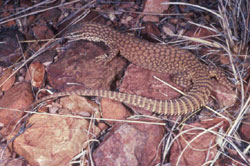Varanus Acantiiurus
Spiny-tailed goannaVaranus acanthurus acanthurlls Roulenger1885
Varanus aranthums brachyurlls Sternfeld 1919
Varanus aranthums insulanicus Mertens 19511
The spiny-tailed goanna is found throughout northern Australia (except the east of Queensland) and also inhabits many islands off the northern and western coasts. It may be ahsent from areas of the Northern Territory inhabited by Vharirji. Three subspecies have heen desuibed: V.acanthurus acanthurus from easterly parts of the range, V.acanthurus brachyurus from the west and V.acanthurus insulanicus from Groote Eylandt and Marchinbar Island in the Gulf of Carpentaria. Storr (1980) did not consider V.brachyurus to be a valid subspecies, but he remarked on peculiarities in specimens from some islands (Barrow and South Murion) off Western Australia. Case & Schwaner (1993) noted that animals from Barrow Island were significantly smaller than those on the mainland. Specimens from southern locations tend to be more brightly coloured and have shorter tails than those from the north with populations in the north-west Kimberleys and on islands in the Gulf of Carpentaria being virtually black with only a few lighter markings (Storr 1980; King & Horner 1987). Colour and pattern do not differ significantly between juveniles and adults. They reach a maximum of about60cm TL (25cm SVL).
The spiny-tailed monitor lives in a variety of tropical and Subtropical habitats and is particularly associated with rocky areas. However they will also live in trees (Stammer 1970) or in burrows (Swanson 1979) and have been collected from beneath spinifex grass (Smith 1976). In stony areas they like to shelter in rock crevices (where they use their spiny tails to wedge themselves into inaccessible cracks) or in burrows under slabs of rock (where they use the tail base to block the burrow entrance). The spiny tail is wielded like a club with considerable force (Thompson & Hosmer 1963; Swanson 1979; Stanuner 1970; Auffenberg 1983a). The western "brachyurus" may be more arboreal in habit than "acanthurus". In areas without outlying rock they may spend the coolest parts of the year in tree hollows (Stammer 1970). Stammer also records that the lizards take refuge in labyrinths of burrows covering about 0.5m2 but only 20cm deep. Bustard's (1970) remarks that this species lives in colonies are thought actually to refer to V.storri (Greer 1989) but the lizards' dispositions in captivity suggest that they could live in close association with each other. Females are encountered as often as males. but may not grow to as large a size (King & Rhodes 1982; Fitch 1981). Mating occurs in the late dry season (August - November) and a single clutch of 2-11 eggs is laid which hatch during the wet season (December and January) (King & Rhodes 1982). A nest examined in the Northern Territory had been dug into a mound of bulldozed soil and consisted of an "s" shaped tunnel tenninating in an egg chamber 40cm below the surface. The tunnel had been refilled with soil and the eight newly hatched youngsters were digging themselves out (Husband 1979). Wilson & Knowles (1988) note that the severed tails of these animals are sometimes encountered and suggest th at this armoured appendage is considered inedible and discarded by predators.
The spiny-tailed goanna feeds mainly on invertebrates (particularly orthopterans and beetles) and other lizards (geckoes, agamids and skinks). They are known to be cannibalistic in captivity and may eat smaller varanids in the wild. Most specimens examined contain less than three prey animals in their stomachs (Losos & Greene 1988). The metabolic rate of this species is lower than that of similarly sized species, suggesting that they may catch a lot of food by ambushing it rather than actively seeking it out and chasing it down. Oxygen consumption has been measured at 0.057-0. 196 ml of oxygen per kilo per hour (Dryden, Green et al 1990 ;Thompson & Withers 1994).
Spiny-tailed goannas have been bred many times in captivity and third and fourth generation captive bred animals have been produced (e.g. Murphy 1972; Jauch 1984, Erdfelder 1984; Horn & Visser 1989; Thissen 1991 , 1992; Visser 1993; Eidenmuller 1994). This monitor is easy to sex by looking for clusters of well developed spiny scales on the tail base at either side of the vent in males. Unlike many monitors they seem to tolerate each other most of the time. Colonies of up to five animals can be housed in an enclosure with 1m2 of floor space but the animals should be separated for a short period each year. Best results have been obtained by using ultra-violet light, a deep (20cm) sand substrate and simulating seasonal light and temperature changes. Winter temperatures as low as 14°C are safe. During the summer the animals (particularly the females) like to bask at high temperatures (up to 44°C). Mating behaviour usually coincides with the onset of spring. In captivity a second clutch of eggs may be laid shortly after the first. Eggs incubated in venniculite with high humidity (around 100%) at 26-32DC hali:h after 90-166 days. Spiny-tailed goannas thrive on a diet of large insects and small rodents. Unequal sex ratios have been noticed in clutches incubated in captivity, prompting suggestions that the sex of hatchlings may be influenced by incubation temperature. Hatchlings weigh from 3.5-9g, probably depending largely on the age and size of the female. They become sexually mature at around 11cm SVL (King & Rhodes 1992). Given good conditions they can attain this size in less than a year (Husband 1979). They can live for more than ten years in captivity (Snider & Bowler 1992).
Attribution / Courtesy: Daniel Bennett. 1995. A Little Book of Monitor Lizards. Viper Press U.K.





